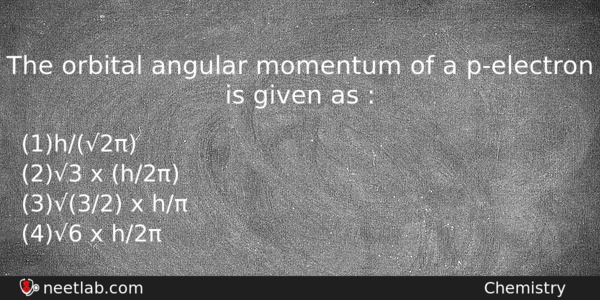| ⇦ | 
| ⇨ |
The orbital angular momentum of a p-electron is given as :
Options
(a) h/(√2π)
(b) √3 x (h/2π)
(c) √(3/2) x h/π
(d) √6 x h/2π
Correct Answer:
h/(√2π)
Explanation:
Orbital Angular Momentum = h/(2π) x √(l(l+1)). For p orbital, l=1. so => h/(2π) x √2 =? h/(√2π)
Related Questions: - The first ionization potentials (eV) of Be and B respectively are
- The crystal structure of NaCl is
- Reaction of solid KMnO₄ ith conc.H₂SO₄ produces manganese heptoxide (Mn₂O₇) in
- Which is insoluble in water
- The C-C bond length is longest in
Question Type: Memory
(964)
Difficulty Level: Easy
(1008)
Topics: Structure of Atom
(90)
Subject: Chemistry
(2512)
Important MCQs Based on Medical Entrance Examinations To Improve Your NEET Score
- The first ionization potentials (eV) of Be and B respectively are
- The crystal structure of NaCl is
- Reaction of solid KMnO₄ ith conc.H₂SO₄ produces manganese heptoxide (Mn₂O₇) in
- Which is insoluble in water
- The C-C bond length is longest in
Question Type: Memory (964)
Difficulty Level: Easy (1008)
Topics: Structure of Atom (90)
Subject: Chemistry (2512)
Important MCQs Based on Medical Entrance Examinations To Improve Your NEET Score
18000+ students are using NEETLab to improve their score. What about you?
Solve Previous Year MCQs, Mock Tests, Topicwise Practice Tests, Identify Weak Topics, Formula Flash cards and much more is available in NEETLab Android App to improve your NEET score.
Share this page with your friends

Leave a Reply